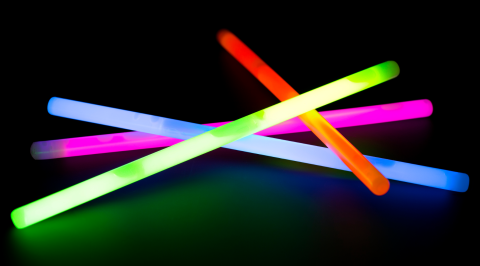One night, two summers ago, when my husband and I were on vacation, we were bused to the shores of the Luminous Lagoon in Falmouth, Jamaica. The lagoon is located where the Martha Brae River meets the Caribbean Sea. It is home to millions of microscopic organisms called dinoflagellates. These organisms thrive in the brackish water, a mix of fresh and salt water from the river and the sea. When the boat was far enough from the shore, the boatmen turned off the lights and the motor, then encouraged us to go for a swim. I chose not to, but my husband and a few others did. I spectated because my leg wasn't strong enough for swimming at the time, as I was recovering from surgery. As the swimmers moved through the water, it glowed with a fluorescent blue light, disturbed by their strokes. It was fascinating that the glow followed the direction of their arm and leg movements. It was a stunning experience. We were told that the organisms were harmless. We could even collect a sample of water in an empty bottle, and it would glow in the dark for hours.
Why & How Organisms Glow in the Dark

Have you ever wondered how and why organisms glow in the dark? Certain chemical reactions produce energy in the form of light, called chemiluminescence. Have you used glow sticks at concerts or while camping? A glow stick has an inner tube and an outer tube filled with specific chemicals. The outer tube also contains a special dye. To activate a glow stick, bend it until you hear a crack. The crack breaks the inner tube, allowing the chemicals to mix and start a chemical reaction that emits light. When this reaction occurs in living organisms, it's known as bioluminescence. Fireflies, deep-sea fish, worms, squid, jellyfish, beetles, and even some mushrooms exhibit bioluminescence. There is a mushroom called Jack-O-Lantern that emits a fluorescent green light in the dark. We found a clump of these mushrooms last fall while camping, brought it to the bathroom, and turned off the light. It was pitch black, but after about five minutes, the mushrooms glowed with a fluorescent green.
Bioluminescent animals contain a chemical called luciferin, which produces light when it reacts with oxygen. Animals use bioluminescence to surprise prey, illuminate prey for predators, or attract prey. It is also used to attract mates or to distinguish between male and female species. The glowing light can serve as a warning to predators that the prey is toxic. About 1,500 species of fish and 76% of marine organisms exhibit bioluminescence.1

Call to Action: Glow in the Dark for Jesus!
We may not glow in the dark, but if we have God’s love shining in our hearts, we will draw others to Christ. John 8:12 says, “I am the light of the world. Whoever follows me will never walk in darkness but will have the light of life.” As “children of light” (Ephesians 5:8), we can share the light of God’s love with those around us by loving Jesus, following His teachings, and maintaining a close relationship with Him. When we love Jesus, we can truly be witnesses for Him and a light to others in a world filled with spiritual darkness.
“You are the light of the world—like a city on a hilltop that cannot be hidden. No one lights a lamp and then puts it under a basket. Instead, a lamp is placed on a stand, where it gives light to everyone in the house. In the same way, let your good deeds shine out for all to see, so that everyone will praise your heavenly Father."
Matthew 5:14-16 (NLT)

- https://oceanconservancy.org/blog/2019/08/06/animals-glow-bioluminescence/




